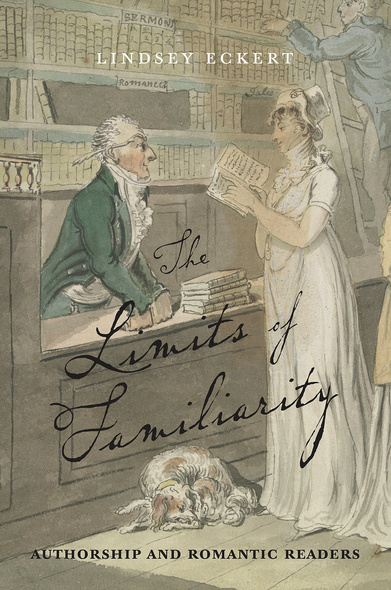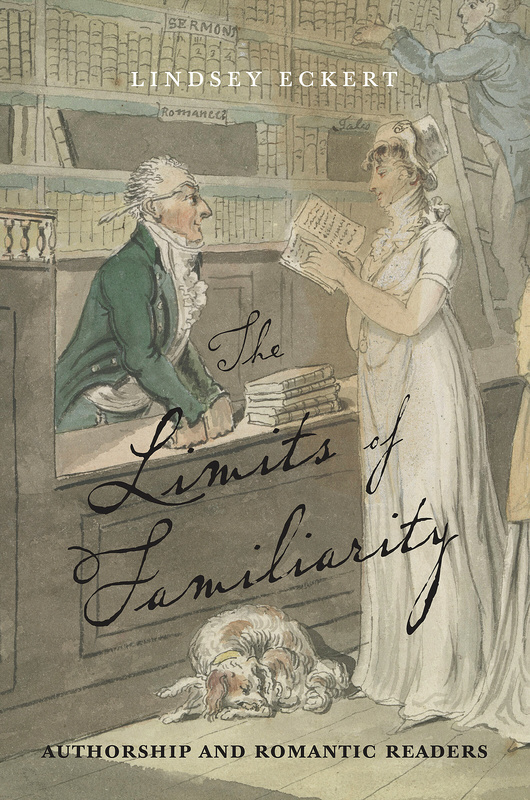
258 pages, 6 1/8 x 9 1/4
6 b&w images, 3 color images
Paperback
Release Date:17 Jun 2022
ISBN:9781684483907
Hardcover
Release Date:17 Jun 2022
ISBN:9781684483914
The Limits of Familiarity
Authorship and Romantic Readers
Bucknell University Press
What did Wordsworth wear, and where did he walk? Who was Byron’s new mistress, and how did his marriage fare? Answers—sometimes accurate, sometimes not—were tantalizingly at the ready in the Romantic era, when confessional poetry, romans à clef, personal essays, and gossip columns offered readers exceptional access to well-known authors. But at what point did familiarity become overfamiliarity? Widely recognized as a social virtue, familiarity—a feeling of emotional closeness or comforting predictability—could also be dangerous, vulgar, or boring. In The Limits of Familiarity, Eckert persuasively argues that such concerns shaped literary production in the Romantic period. Bringing together reception studies, celebrity studies, and literary history to reveal how anxieties about familiarity shaped both Romanticism and conceptions of authorship, this book encourages us to reflect in our own fraught historical moment on the distinction between telling all and telling all too much.
In this fascinating book, ‘familiarity’ emerges as a crucial term for understanding Romantic-period culture. Eckert shows how authors walked a tightrope between cultivating familiarity with their readers and being overfamiliar towards them. Archival research, astute historical interpretation, and insightful criticism combine to reveal a history that resonates in the present.
With a wonderful eye for detail, Eckert opens rewarding angles of view on the often-contentious back-and-forth between authors and their publics that shaped Romantic-era literary culture. This remarkably lucid study contributes valuable new understanding both of writers’ careers and of the activity of readers across multiple spheres of reception.
In her lucid examination of relationships between authors and readers, and especially writers’ attempts to negotiate the boundaries between personal closeness and public exposure, Eckert establishes familiarity’s centrality—as both promise and problem—to Romantic authorship.
The Limits of Familiarity uses an impressive array of archival materials and its case studies are meticulously detailed...[Eckert] shows the tenuousness of the line between familiarity and over-familiarity—the same author can be praised or pilloried, depending on the cultural mood. [I]t is a book focused on a particular historical moment. Yet its resonances ring far wider.'
With a wonderful eye for detail, Eckert opens rewarding angles of view on the often-contentious back-and-forth between authors and their publics that shaped Romantic-era literary culture. This remarkably lucid study contributes valuable new understanding both of writers’ careers and of the activity of readers across multiple spheres of reception.
In her lucid examination of relationships between authors and readers, and especially writers’ attempts to negotiate the boundaries between personal closeness and public exposure, Eckert establishes familiarity’s centrality—as both promise and problem—to Romantic authorship.
In this fascinating book, ‘familiarity’ emerges as a crucial term for understanding Romantic-period culture. Eckert shows how authors walked a tightrope between cultivating familiarity with their readers and being overfamiliar towards them. Archival research, astute historical interpretation, and insightful criticism combine to reveal a history that resonates in the present.
. . . a complex, enticing picture of Romantic celebrity—one that expands the terrain beyond the stories we’re used to.
Required reading for anyone interested in the history of Romantic readerships, media history, or the culture of celebrity, The Limits of Familiarity makes new and productively strange the concept of the familiar for Romanticist scholarship.
The Limits of Familiarity draws on a wealth of source material from the prose nonfiction framework that scaffolds literary production, including private correspondence, reviews, the prefaces that frame collections of poetry, and the letters that fans of those poetry collections sent to their authors. . . . Eckert’s analysis is satisfyingly thorough, and will be valuable for anyone interested in the reception history of celebrity, media history, and the power dynamics that shape popular and literary culture.
LINDSEY ECKERT is an assistant professor of English at Florida State University in Tallahassee, where her research and teaching focus on Romanticism and the history of text technologies.
List of Illustrations
Acknowledgments
List of Abbreviations
Introduction: Familiarity’s “ due bounds”
1. Charlotte Smith, William Wordsworth, and the Problems of Reading Familiarity
2. “Though a stranger to you”: Byron’s Poetics of Familiarity and Readerly Attachment
3. Lady Caroline Lamb’s Female Follies and the Dangers of Familiarity
4. “the whole cursed story”: William Hazlitt’s Familiar Style
5. Mediating a Manuscript Ethos: Familiarity in Albums and Literary Annuals
Coda: Lifting “the film of familiarity”
Notes
Bibliography
Index
Acknowledgments
List of Abbreviations
Introduction: Familiarity’s “ due bounds”
1. Charlotte Smith, William Wordsworth, and the Problems of Reading Familiarity
2. “Though a stranger to you”: Byron’s Poetics of Familiarity and Readerly Attachment
3. Lady Caroline Lamb’s Female Follies and the Dangers of Familiarity
4. “the whole cursed story”: William Hazlitt’s Familiar Style
5. Mediating a Manuscript Ethos: Familiarity in Albums and Literary Annuals
Coda: Lifting “the film of familiarity”
Notes
Bibliography
Index




